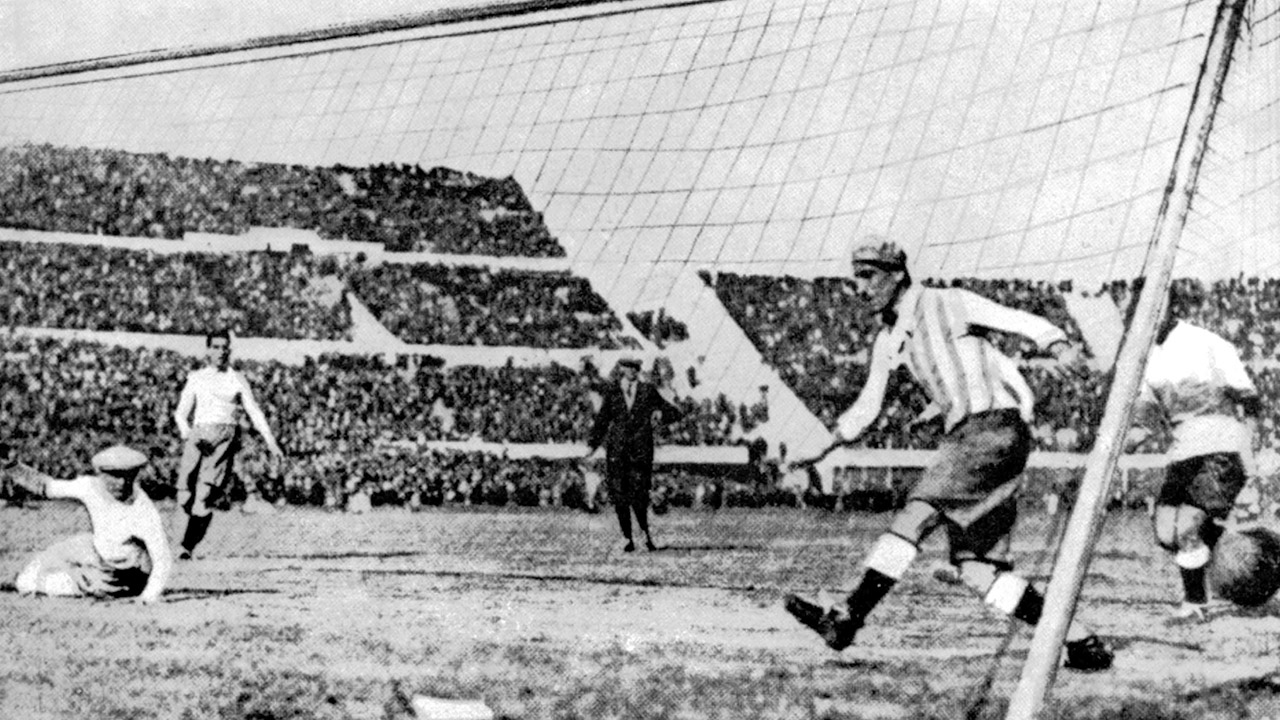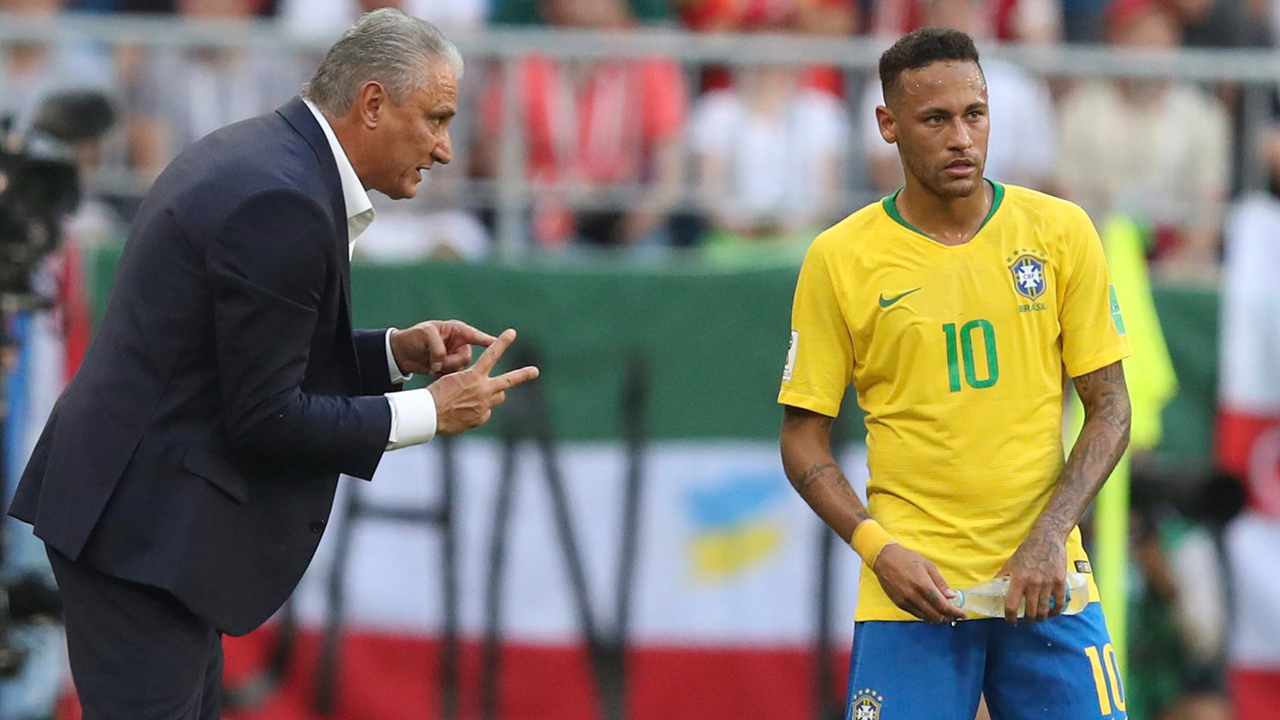Uruguay welcomed and then conquered the world, using home-field advantage to defeat South American rivals Argentina in the final of the inaugural World Cup in 1930.
THE MAIN STORY
The fact that the first World Cup was awarded to South America to begin with did not sit well with Europe and almost derailed the tournament before a ball was even kicked. The other aspiring host countries — Italy, the Netherlands, Spain and Sweden — thumbed their noses at FIFA and decided not to participate.
Although Uruguay offered to pay all travel and hotel expenses for the visiting teams, the prospect of making the long boat ride — a three-week journey in those days — dissuaded the Europeans from coming. Two months before the scheduled start of the World Cup, not a single European nation was committed to playing. Finally, FIFA president Jules Rimet stepped in and exerted some pressure. Belgium, Romania, Yugoslavia and France all did an about-face and decided to participate.
The four European teams set sail together from Villefranche-Sur-Mer, a small town on the French Riviera, on June 21, 1930 — stopping in Rio de Janeiro to pick up the Brazil team — before finally arriving in Montevideo on July 4.
[snippet id=3758859]
TOURNAMENT FORMAT
Unlike today when teams fight to qualify, the first World Cup was by invitation only. The 13 teams were divided into four groups: Pool 1 consisted of Argentina, Chile, France and Mexico; Pool 2 saw Yugoslavia grouped with Brazil and Bolivia; Uruguay competed in Group 3 alongside Romania and Peru, while Pool 4 was made up of the U.S., Belgium and Paraguay. The four pool winners advanced directly to the semifinals.
THE FINAL
The day before the final, thousands of fans in the Argentine capital of Buenos Aries made the trip across the River Plate by boat to see their heroes try and vanquish Uruguay in the all-South American final. A crowd of 90,000 spectators jammed into Montevideo’s Centenario stadium for the electric matchup on July 30. Comically, the game was delayed when both teams insisted on using a ball of their own choice.
Pablo Dorado put the home side up after only 12 minutes, but Carlos Peucelle equalized eight minutes later for Argentina when he beat Uruguay goalkeeper Enrique Ballesteros with a powerful shot. The visitors took a 2-1 lead before halftime when Guillermo Stabile, the tournament’s top scorer, found the back of the net. Uruguay captain Jose Nasazzi protested that Stabile was offside, but Belgian referee Jean Langenus let the goal stand.
The second half was all Uruguay. Pedro Cea went on a scintillating run and drew Uruguay even with his goal in the 57th minute. Santos Iriarte made it 3-2 in the 68th minute, and Hector Castro sealed the result with his second goal of the tournament in the final minutes, scoring on a header off a cross from Dorado. Uruguay was crowned champion, and the World Cup was well on its way to becoming the biggest sporting event in the world.
QUICK FACTS
Number of participating teams: 13
Top scorer: Argentina’s Guillermo Stabile (8 goals)
Number of games: 18
Total goals scored: 70
Average goals per game: 3.89
Highest scoring game: Argentina’s 6-3 win over Mexico on July 19
Total attendance: 434,500
Average attendance: 24,139
MAN OF THE TOURNAMENT
Guillermo Stabile. Nicknamed El Enfiltrador — The Infiltrator, Stabile sat out the first game and was only called into duty in Argentina’s second contest when a teammate could not play. The Argentine ace went on to bag eight goals in four matches — including a hat trick against Mexico — to finish as the top scorer in the tournament.
MATCH OF THE TOURNAMENT
Uruguay’s 4-2 victory over Argentina in the final. Down 2-1 at halftime and buoyed by the sea of rabid fans packed into Montevideo’s Centenario stadium, Uruguay came alive in the second half to defeat its South American rival.
LAURENT MAKES HISTORY
The first goal in World Cup history was scored by Lucien Laurent in the 19th minute of France’s 4-1 win over Mexico on July 13. Laurent, the only surviving member of the 1930 French team to see France win the 1998 World Cup on home soil, died April 11, 2005 in Besançon. He was 97.
A ONE CITY WORLD CUP
The entire tournament was played in one city — Montevideo — and only three stadiums were used to host all 18 games: Centenario (built specifically for the World Cup), Pocitos and Parque Central. Centenario was not completed in time for the start of the World Cup — three months of rain slowed things down. Five days into the tournament, construction on Centenario was completed and Uruguay christened it by defeating Peru 1-0 in its opening match. Centenario could hold approximately 100,000 spectators, but attendance for the Uruguay-Argentina final was limited to 90,000. The largest crowd of the tournament was 93,000 for Uruguay’s 6-1 win over Yugoslavia in the semifinals.
WHO SCORED THE FIRST HAT TRICK?
Bertram Patenaude of the U.S. is recognized by FIFA as having netted the first hat trick in World Cup history, scoring all three goals in a 3-0 win over Paraguay on July 17. However, some historians say Argentina’s Guillermo Stabile was the first to do it, with three goals two days later against Mexico. Some match reports list Patenaude’s second goal against Paraguay as credited to Thomas Florie.
DIFFICULT TO GET TIME OFF WORK
Romania only agreed to play in the World Cup after King Carol gave the players time off from their work so they could compete and guaranteed that their jobs would be waiting for them upon their return from Uruguay.
FROM THE “WHAT WAS HE DOING?” FILE
Brazilian referee Almeida Rego mistakenly stopped the July 15 game between France and Argentina when he blew the final whistle six minutes too early. After fierce protests from the French players, he realized his error and re-started the match. Argentina, leading 1-0 before Rego’s mistake, held on for the win.
TALK ABOUT LONGEVITY
Argentina’s Francisco Varallo was the last survivor of the first World Cup final. Born Feb. 5, 1910, the former Argentine striker outlived all 21 other players from the 1930 final. He died on Aug. 30, 2010, at age 100.
QUIRKY FACTS
• The day after the 1930 final, July 31, was declared a national holiday in Uruguay.
• Only 300 fans attended Romania’s 3-1 win over Peru on July 14 in the first round, the lowest recorded attendance for a single game in World Cup history.
• Mario de Las Casas holds the distinction of being the first player in World Cup history to be expelled. He was sent off in Peru’s 3-1 loss to Romania in the first round.
• The first goal scored on a penalty shot in the World Cup was by Manuel Rosas of Mexico. He beat Argentine goalkeeper Angelo Bossio.
• The draw for the 1930 World Cup did not take place until the teams arrived in Uruguay just days before the tournament began.









